Sonamarg
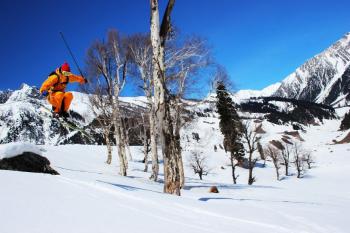
Sonamarg means (The Meadow of Gold), situated at an altitude of 2730 m. It is an alpine valley is situated at the bank of Nallah Sindh (the largest tributary of the Jehlum River in the valley of Kashmir) at distance of 87 km north-east from Srinagar, this place is renown for trekking and hiking trails. The snow clad peaks in the Himalaya and the hilly mountainous regions are perfectly suitable for all types of trekking expeditions. Sonamarg is the base camp for many trekking expeditions. The major treks passing through various mountain lakes such as Gangabal, Vishansar, Gadsar, Satsar and Kishansar has its base at Sonamarg. The trekking routes offer all types of challenges, from mild to most hard. The pleasant climate with mild summer and cold winter make this place an ideal location for trekkers to explore the natural beauty and challenging treks.
Amarthnath Yatra Via Sonamarg: Sonamarg also provides alternative route for Amarnath Yatra via Baltal
This enchanting scenic place is amazing with many mind blowing attractions. Sonamarg is the home of many beautiful and serene lakes. Various mountain lakes such as Gangabal, Vishansar, Gadsar, Satsar and Kishansar are situated in and around, Sonamarg.
Vishansar: Located at an amazing altitude of 4,084 m above sea level, is a scenic eye catching lake in Sonamarg. The gorgeous views of this lake can be experienced from Nichnai Pass. Trekking freaks can get into their trek to this lake from Sonamarg.
Krishnasar Lake: At a height of 3,801m above sea level, is popular for fishing especially for trout fishing. In its vicinity lies the great Himalayan glaciers of Kashmir Valley namely Kolhoi Glacier and Machoi Glacier with some peaks of above 5000 meters; Sirbal Peak, Kolhoi Peak, Amarnath Peak and Machoi Peak.
Sonamarg has no permanent settlement and is inaccessible during winter due to heavy snowfall and avalanches. It remains open only for Summer season from April-May, it is a beautiful place to visit in summer and is one of the main tourist attraction of Kashmir during Summers, Thajiwas glacier a major attraction during the summer months.
Sonamarg had historical significance and was a gateway on ancient Silk Road along with Gilgit connecting Kashmir with China and other Gulf countries. The Zojila pass lies 15 kilometers east and is one of the highest passes for road transport. It still is a base camp for Ladakh on NH 1D, and is strategically important for Indian army who holds control over this part of Kashmir.
A close by excursion is to Baltal, 15 km East of Sonamarg. This little valley lies at the foot of the Zojila, only a day's journey away from the sacred cave of Amarnath is a base camp for Amarnath yatra. Trekkers can also reach the starkly splendid roof-top of the world Leh, by crossing over the Zoji La pass.
This place is also famous for Film making, a large number of Hindi movies have been pictured in the serene beauties of Sonamarg.
Major Attraction / Places to visit:
• Thajiwas Glacier.
• Zojila Pass.
• Gangabal Lake.
• Zoji La Pass.
• Thajwas Glacier.
• Gadsar Lake.
• Baltal Valley.
• Satsaran Pass.
• Nichinai Pass.
• Krishnasar Lake.
• Satsar Lake.
• Vishansar Lake.
Activities to do in Sonamarg: Sonamarg is also known for providing the opportunities to adventurer lovers. It offers us platform for Trekking, Camping, Hiking, River Rafting, paragliding, Skiing and Mountaineering. Sonamarg is an only place where all these activities take place.
Where to Stay: There are Delux and Semi Delux Hotels, hotels of category A, B and C (Both in Low and High Budget), equipped with modern facilities. Besides Hotels tourist huts and Guest houses managed by Jammu and Kashmir Tourism Developement Corporation are there.
Best Time to Visit Sonamarg: The period between May to October is the best time to visit Sonamarg as the weather is good for outdoor activities and adventurous activities.
Climate: The climate of Sonamarg is very bracing, but the rainfall is frequent though not heavy, except for two or three days at a time in July and August with fine spell in between.
Clothing:
Summer: Summer Clothes, Light Sweater / Rain Coat.
Winter: Heavy woolen Clothes.
How To Reach: Sonamarg is easily accessible from Srinagar or Srinagar Airport by Road, in under 3 hours by car or bus (87 kilometers drive) which leads along Nallah Sindh a key tourist attraction. Sonamarg is inaccessibe during winter due to heavy snowfall and avalanches, the Sonamarg Highway is being closed in December every year for Tourists
Srinagar

Dachigam National Park:
Dachigam National Park is wildlife and environment conservation is located 22 kilometers from Srinagar, Jammu and Kashmir. It covers an area of 141 km2. The park has been a protected area since 1910. It was initially created to ensure clean drinking water supply for the Srinagar by the Maharaja of Kashmir, later on was upgraded and declared a National Park by Government in year 1981.
This national park has a rich flora that includes about 500 herb species, 50 types of trees and 20 varieties of shrub. From dense forests to sprawling grasslands, it has a variety of ecosystems that are inhabited by various animals. This place earns widespread recognition for being the habitat of the last surviving population of Hangul (Kashmir Stag), besides these Himalayan Black Bear, Long-tailed Marmots, Leopard, Jackal, Red Fox and Common Palm Civet, other animal species and about 145 bird species can be spotted here.
Burzhama Ruins:
The ancient Burzahama Ruins, are situated in the northwestern end of Kashmir which is about 27 kms in distance from Srinagar. Burzhama Ruins are remnants of an ancient settlement that existed in the valley of Kashmir millenniums ago. These archaeological remains are situated in the city of Srinagar, which has come a long way since its establishment in olden times.
Discovered during a detailed survey and excavation by the archaeological department, these Neolithic vestiges tell about the birth of human civilization in the valley. During excavations, several significant findings about the settlement and its inhabitants were made.
These include artifacts like earthen utensils, bricks and tools that have been preserved. The development of this civilization has been divided into four varied stages, which depict the gradual transition from mud to brick houses. Carvings and paintings of those times are also preserved at this site.
The quaintness of Burzhama Ruins attracts visitors who are interested in knowing about various civilizations. Here one can click photographs of the excavated site, which has old buildings and other interesting archaeological remains.
Nilagrad River:
Nilagrad River is a gushing mountain stream that forms an integral part of Kashmirs breathtaking landscape. At Baltic Colony, it merges with the watercourse of Indus – one of the longest rivers across the world. The water of this river carries a reddish hue, which makes it different from other water bodies in the region. Natives believe that this water carries curative properties that heal many ailments. Owing to this belief, people gather here in large numbers on Sundays to take a bath in its supposedly healing water.
Botanical Garden:
Botanical Garden lies in the foothills of the Zabarwan mountain range and overlooks the picturesque Dal Lake. This well quaint garden covers an area of 80 hectares, of which 17 hectares is occupied by a beautiful lake. It was established in 1969, with the aim of spreading awareness about various varieties of flora and beautifying the city.
There are four main divisions of this sprawling green space, namely Plant Introduction Centre, Research Section, Recreational Garden and Botanical Garden. It features several styles of inner gardens that can satiate the inner senses of the tourists and hence, this is the best place to unwind and rejuvenate. There is a beautiful lake spread across a land of 17 hectares that offers paddle boat facilities to the tourists. More than 300 species of flora dot the landscape of this garden, including trees of willow and cedar.
Indira Gandhi Memorial Tulip Garden: It is one of the recent additions to the multitude of tourist attractions in Srinagar. It is the largest Tulip garden of Asia spread over an area of about 12 hectares. It is situated on the foothills of Zabarwan Range with an overview of picturesque world famous Dal Lake. This seemingly endless green patch of land is dotted with about 20 lakh flowers, which include several varieties of tulips.
Tulip Festival is organized at this site in March or April every year, when tulip flowers are in their full bloom. During this flower festival, several cultural programmes as well as exhibitions of local handicraft and cuisine are organized.
Manasbal Lake:
Manasbal Lake is a picturesque water body that lies towards the north of Srinagar in Safapora area of Ganderbal. The name Manasbal is said to be a derivative of the sacred and mythological lake of Mansarovar and is stated to be the deepest lake (at 13 m or 43 ft depth) in India. The green waters of this lake are dotted with beautiful flowers of lotus that add to its beauty. Several birds can be spotted on the shore of this lake, which make it a paradise for birdwatchers and ornithologists. The lake is a good place for bird watching as it is one of the largest natural stamping grounds of Aquatic birds in Kashmir and has the sobriquet of "supreme gem of all Kashmir Lakes".
The lake is overlooked by remains of Darogabagh – a 17th century fort and Jharokha , a beautiful Mughal Garden, Shikaras can be seen floating on this lake, which form a spectacular sight to behold. Visitors can enjoy a number of leisure activities here, including boat riding, fishing and water skiing.
Nagin Lake in Srinagar:
Nagin Lake got its name from the trees surrounding the lake. Popularly known as the 'Jewel in the Ring', it is one of the beautiful lakes in east Srinagar. Nagin Lake is a beautiful water body, known for its sparkling waters and picturesque surroundings. It is nestled in the foothills of the Zabarwan ranges and is bordered by the lofty Hari Parbat and Shankaracharya Hill.
This lake attributes its name to the trees that surround it and earns the sobriquet 'Jewel in the Ring'. The deep blue surface of this lake shimmers with the touch of sunrays that forms a mesmerizing visit. It is separated from Dal by a thin embankment. Visitors coming to this lake can take a refreshing dip here as it is considered safe for Swimming. Water Skiing & sailing on fiberglass boats can also be enjoyed here. Nagin Lake has always been a fascinating destination for photography and tourists.
Badaamwari (Almond garden):
Badamwari Garden is located in downtown Srinagar. It is one of the most prettiest sight to see in Spring where the Almond trees are in full bloom. Situated on foothills of Koh-e-Maran, the 300 kanals garden was dotted with trees, flowers and cascades providing a soothing experience to the visitors. This is for all the crazy nature lovers, a place which can't be missed in spring n summer in Kashmir.
HokarsarLake:
Hokarsar is a clean and pure water lake located about 13 km from Srinagar, in Jammu and Kashmir. Lying on the Srinagar-Baramulla road, it is 5 km long and 1.5 km wide. Willow trees found in abundance along its banks offer an enchanting sight. The lake is also a favorite hunt for winter migratory birds.
Pari Mahal:
It is counted amongst the star attractions of Srinagar. It is also known as The Fairies Abode, it is a seven terraced garden situated to the southwest of Dal Lake, above the famous Chashme Shahi Garden in Zabarwan mountain range.
Mughal emperor Shah Jahan's son Dara Shikoh built this garden in the memory of Mullah Shah Badakhshi. It was established in the mid 17th century on the remnants of an old Buddhist monastery. The monumental garden was used as an astronomical observatory and an important learning centre for astrological science.
This beautifully landscaped garden covers a sprawling area that is 122 metres in length and 62.5 metres in width. It comprises of seven terraces, which have separate water tanks that are filled through underground pipes. The verdant and well-manicured lawn with colourful flowers and fruit trees adds to the overall appeal of this green space. A water spring also forms a part of this beautiful garden.
Hari Parbat in Srinagar
Hari Parbat (SHARIKA PEETH) is a popular tourist attraction situated at the periphery of Srinagar city, is an ancient and one of the holiest place of Kashmir. It is the abode of Maha Shakti. The Divine mother of Shri Jagat Amaba Sharika Bagwati also known as Maha TRIPURSUNDHARI OR RAJESHWARI locally called HARIE. The EIGHTEEN ARMED goddess SHARIKA is regarded as the presiding deity (ISHT-DEVI) of Srinagar city. It is the site of several important edifices, which include the Durrani Fort, Parvati Temple, a Gurudwara and shrines of Akhund Mullah Shah and Khwaja Makhdoom Sahib. The earliest fortifications on this hill were established by Mughal Emperor Akbar in 1590, when he planned to build a new capital named Nager Nagor. However, not everything went according to plan. The present citadel was constructed in 1808 under the supervision of Shuja Shah Durrani.
There are two mythological legends associated with Hari Parbat, which is also known as Koh-e-Maraan. The first one states that this hill was originally a huge lake, where a demon named Jalobhava resided. To get rid of his atrocities, the natives prayed Hindu Goddess Parvati for help. She turned into a bird and dropped a pebble on his head. The pebble kept increasing in size until the demon's head was crushed. It is said that Hari Parbat is the same enlarged pebble, which became the abode of all Hindu gods.
Another version of the tale is similar but includes two demons – Tsand and Mond.
Kathi Darwaza:
Kathi Darwaza is the main entrance gate to the Hari Parbat Fort, which majestically stands atop a hill, overlooking Srinagar. It is a fine specimen of the splendid Mughal architecture. A domed chamber flanked by two bays is present at the centre of this imposing gateway. The gate reflects Mughal style of architecture and features elaborate Persian inscriptions.
Photography Option: Hari Parbat offers a stunning panorama of the beautiful city of Srinagar.
Gulmarg

Gulmarg means meadow of Flowers, a large meadow situated in the lap of Mount Affarwat at an altitude of 2820 mtrs above sea level, it is 52 kms away from Srinagar (90 minutes drive). It is a popular day trip resort from Srinagar but many tourists extend their stay to enjoy the natural scenic beauty. The Gulmargs legendry beauty, prime location and close proximity to Srinagar and airport make it one of the premier resort of Kashmir. The place in the beginning was called Gourimarg mostly by the shepherds, named by one Sadhu namely VINAIK, on the name of his beloved GAURI, formally as per history reveals that Gulmarg was discovered in the 16th century by Sultan Yousuf Shah Chak a Mughal Emperor, who was inspired by the natural lush green scenic grassy slopes and the wild flowers. It was also the favourite hill resort of Mughal Emperor Jehangir. It is like a bowl / small valley in round shape covered by all the side with thick forests, which make unique than others.
Gulmarg is not merely a hill resort of exceptional natural beauty but is also the countrys premier Ski resort. The ski in this resort has been introduced by the british in 1927. Skiing makes it one of the worlds main attractions during winter, people from all the corners of the world throng this place to taste the real adventure of Skiing.
What To see:
Sight Seeing Places within Gulmarg:
Outer Circular road, which covers whole gulmarg in circle = 11 kms.
Inner Circular Road = 7 Kms
Maharaja Palace
Saint Merys Church
Maharani Temple
Childrens Parks with lake for boating.
Golf Club
Gondola Ride From Gulmarg to Khilanmarg, From Khilanmarg to Mount Apharwat. From Mount Apharwat on can have the view of whole Valley.
Besides the Gulmarg Bowl there are many other beautiful places in its vicinity where one can enjoy.
Khilanmarg: Khilanmarg is an uphill 4 kilometers journey from Gulmarg. It offers a natural green carpeted with wild flowers and unrivalled spactle of the peaks and the wide spreading waters of Seven Spring Lake. Khilanmarg is base of the mount Affarwat, one can have full view of Mountain from here. It is accessible by Gondola and by Ponies.
Alpather Lake: It is 13 kms backside of the main Apharwat peak. The water of this lake remains frozen till the middle of June carrying floating snow. It is accessible by Pony / Foot from Gulmarg, or by foot from phase 2nd of Mount Apharwat.
Ningli Nallah: It is about 12 kms from Gulmarg, the stream flows from the snow bed and spring near Apharwat and Alpather lake, and cuts through picturesque pine forests. It is accessible by Pony.
Shrine Of Babareshi: It is a famous muslim Shrine 4kms from the middle Gap of Gulmarg, east of Gulmarg, the road leads down through thick forests and can be accessed by foot, pony and car also. The Shrine is of famous saint Hazrat Baba Payam-ud-Din Reshi the disciple of Baba Shakuruding, he lived here during the Mughal rule. He was a courtier of the Kashmiri King Zainul Abedin and died in 1480. All sects / religions make offering here.
Sranz Babareshi: Saranz Babareshi is a beautiful waterfall and is about 3 kms from Babareshi in thick forests, it is away from tourists rush, but is recommended visit. It is accessible by foot from Babareshi, or by pony as well as car.
Drung Tangmarg: The Tangmarg is located at the lap of Gulmarg, and lies 13 kms before Gulmarg, it is Known as Gateway of Gulmarg, it is a small town with small market. From here DRUNG is about 3 kms by road. Drung is a new tourist destination and is a beautiful destination in pine forests, and River Ferozpora passes through this spot, which makes it attractive for cold, ice chilled fresh water bath, water is coming from Appharwat mountain range.
The river is abundant with trout fishes, fishing can be done in this area after seeking the permission from fisheries department at Tangmarg.
There are also some historical monuments, which are called PANDO LARRI (Constructions of Huge Rocks)
Sports Activities (Summer)
Trekking:
Gulmarg area provide some well defined and adventurous trekking routes:
• Gulmar to Khilanmarg, Apharwat, Alapather= 1 day trek if one starts early morning.
• Gulmarg to Danwas, Pehjan, Toshamaidan via Jamian Gulli = 3-4 days trek.
• Gulmarg to Bota Pathri to Boniyar Uri = 2 days trek.
• Gulmarg to Sranz via Babareshi and Back = 1 day trek.
• Drung to Gulmar, Khilanmarg = 1 day trek.
Sports Activities (Winter):
• Skiing.
• Ice Skating.
• Cross Country Skiing.
• Snow Boarding.
• Sledging.
Horse Riding.
Golf: A newly reconstructed 18 Hole (72 Pars) Golf Course is available for Golfing.
• Besides these Table tennis / Billards / Snooker is also available in the heritage Golf Culb, which is the 2nd Oldest Club of the country.
Best Season to Visit: Gulmarg is in full bloom through out the year.
For Summer Lovers: From April to October.
For Winter Lovers: December to March.
Clothing:
Summer: Summer Clothes, Light weight Sweater / Jacket / Rain Coat precautionary.
Winter: Heavey Winter Clothes. Rain proof jackets / coats, Winter Shoes.
Where to stay:
The Gulmarg resort offers Various types of accommodation in Government sector as well as private sector. All the accommodation is on inner circular road of the Gulmarg. There are hotels of all categories low budget and high budget, deluxe and semi deluxe rooms with latest facilities. Beside the hotels there are also guest houses and wodden huts of J&K Tourism and JKTDC which are available for hiring.
What to eat:One can find all types of meals / dishes here, Indian, Continental, Kashmiri, Chinese is available in all Hotels / Restaurants and Dabas.
How to Reach: Gulmarg is accessible road whole year, it is at 1 ½ -2 hours drive from Srinagar and 30-40 mins drive from Tangmarg. One can enjoy the paddy fields, orchards, Kashmiri people traditional looks and living all the way from Srinagar to Tangmarg, as the road passes through villages and small towns all the way.
Pahalgam

In search of nature's lap for peace of mind or interested in trekking/hiking, rafting, horse-riding, golfing, nature-photography of the best of picturesque Himalayas? Yes, come to Pahalgam, the Shepherds Village, (Pahalgam in Kashmiri means Shepherds Village). It Located in Anantnag district of Jammu & Kashmir. It is a popular tourist destination during summers and every year thousands of tourists visit Pahalgam. This world famous hill station is 45 kms. from the district Headquarters at Anantnag and 89 kms from Srinagar located on the banks of Lidder River at an altitude of 2740 meters above sea level. Pahalgam is a beautiful valley, and the Lidder River running through it makes it even more picturesque, the river is one of the favorite spots for trout fishing in the country. Rafting is also organized at this river. One can spend weeks long there without getting bored. It is also point of attraction and a favourite place for shooting of Bollywood films.
Pahalgam is also associated with the annual Amarnath Yatra. Chandanwari (2,895 m), 16 km from Pahalgam, is the starting point of the yatra that takes place every year in the month of Sawan (July to August). The road from Pahalgam to Chandanwari is on fairly flat terrain and can be undertaken by car. From Chandanwari onwards the track becomes much steeper, and is accessible on foot or by pony. About 11 km from Chandanwari is the mountain lake of Sheshnag (3,574 m), after which, 13 km away is the last stop, Panchtarni. The Amarnath cave is 6 km from there. During the month of Sawan, an ice stalagmite forms a natural Shivling in the Amarnath cave.
Here are 10 interesting things to do when you are in Pahalgam.
Visit Club Park: Club Park is one of the oldest parks in Pahalgam. It is crowded, specifically on weekends. The garden blends perfectly with its surrounding hills and river running nearby and looks more like a naturally created garden.
Stop at Aru Village: Aru village is around 12 km from Pahalgam. Taxis are available from Pahalgam on shared basis. It is a beautiful village, visited by far lesser tourists and is more peaceful than Pahalgam. Some scenes from the film 'Jaab Tak Hai Jaan,' were shot here. The ride from Pahalgam to Aru has some of the most picturesque viewpoints. Aru valley is very famous for sight seeing. Aru is a great place to stay in - in the lap of nature. Options for stay here are rather limited though.
Go camping at Lidder Valley: Lidder valley is a popular camping site. It is around 12 km from Pahalgam and 12 km from the nearest motor accessible village, Aru.
Trout fishing at Lidder River: If you want to indulge in some fishing, there is no better place than Pahalgam. As much fun as it is, it doesn't come cheap. Fishing permits are issued only in Srinagar by the Fisheries Department. If you are a first timer you can hire the service of a shikara (offered by fishermen in this case) but it can be quite expensive. With a permit one can catch fishes in river Lidder, so more or less it is a give and take process but a fun-filled adventure altogether. Pahalgam is thus also known as a 'anglers paradise'.
Jamia Masjid Mosque: The green roof mosque just near the main bazaar (market) with its beautiful design is a major attraction. The location of the mosque also adds another dimension to its aura. The Lidder River below and the mountain as the backdrop make it a peaceful place to worship.
Gauri Shankar Temple: This temple is one of the oldest temples in Pahalgam. The Amarnath Yatra also begins here. The temple is small but much revered by the Hindus.
Visit the zoo: Around 1 km from Pahalgam town, wildlife lovers can see different species of deer, leopard and bear at the zoo.
Visit Betaab Valley: Betaab Valley is 15 km from Pahalgam town and is one of the most beautiful valleys around Pahalgam. The valley is famed as a setting for a popular Bollywood film, Betaab.
Visit Amarnath Cave: Amarnath is a famous cave where myth and beliefs meet. It is believed that Lord Shiva is seated in the cave. The cave was first discovered in 19th century by a local Buta Malik of Batakote. The cave and the naturally formed ice Shiva Linga has become a revered and one of the most popular pilgrimage sites in India. Most pilgrims stop at Pahalgam before continuing their journey to Amarnth. Tourism has flourished here richly after the insurgency problems have dissipated.
Kolhoi Glacier: Kolohoi Glacier, situated up the Lidder Valley, just below Kolhoi Peak is currently a hanging glacier. It is accessible from Pahalgam via Aru.
Rafting: Season for rafting is May to August and the trips go for 30 minutes and approximately 3 km. Each boat takes 6 passengers with 2 rafting guides with helmets and life jackets provided. No experience is required as all training provided,
Trekking:
Pahalgam offers lots of treks:
• Trek to Aru Valley, Kohli Glacier, Tarsar Lake, Chandiwari and Leh.
Where to Stay
There are Delux and Semi Delux Hotels, hotels of category A, B and C (Both in Low and High Budget), equipped with modern facilities. Besides Hotels tourist huts and Guest houses managed by Jammu and Kashmir Tourism Deevelpoment Corporation are there.
Best Time to Visit Pahalgam: The period between April to October is the best time to visit Pahalgam as the weather is good for outdoor activities and adventurous activities
Climate: The climate of Pahalgam is very pleasant with running breeze but rainfall is frequent though not heavy, except for two or three days at a time in July and August with fine spell in between. The presence of river Lidder and gentle winds makes its more beautiful.
Clothing:
Summer: Summer Clothes, Light Sweater / Light Jacket or Rain Coat.
Winter: Heavy woolen Clothes.
How To Reach: Pahalgam is easily accessible from Srinagar or Srinagar Airport by Road, in under 2 hours by car or bus (89 kilometers drive).
Verinag Lake

Located 80 kms from Srinagar at an altitude of 1,876 m, the spring of Verinag is believed to be the chief source of the river Jhelum. It lies at the entry point of Kashmir Valley right after crossing Jawahar Tunnel. The Verinag Spring, named after Nila Nag, the son of the famous Hindu sage Kashyap Rishi, to whom goes the credit of establishing the territory of Jammu and Kashmir is one of the principle tourist attractions of a tour to Verinag.
The spring, which was originally shaped in a circular form was given a change of shape during the reign of the Mughal Emperor Jahangir in 1620, he got the spring renovated in the Mughal traditional shape of an octagon. Verinag Lake waters have a limpid clarity in which the verdant surroundings of pine trees are mirrored. Fish swim in the cool depths and this picturesque setting that so captivated the Mughal emperors has lost none of its pastoral charm over the centuries. The lawns around the spring are a beautifully manicured green, and banks of massed flowers add splashes of colour to this symphony of greens and browns. The circumference of the spring is 80 m and is over 15 m deep. Besides a glimpse of Verinag, a tour to Verinag is made even more special by the sight of several varieties of colorful flowers, gently swaying to the rhythm of the cool, mountain air.
This spring is known to never dry up or overflow. Verinag Spring is also the major source of river Jhelum. Verinag Spring and Mughal Arcade surrounding it is officially recognized by Archaeological Survey of India as a Monument of National Importance.
Kokernag Lake
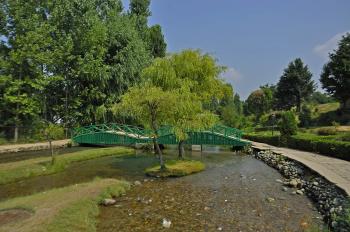
As per one such theory Koker means 'Fowl' and nag means 'serpent'. The spring gushes out of the base of a thickly wooded hill from where it divides into channels, which resembles to the claw-foot of a hen, hence its name. Kokernag is at the height of approx 2000 mts from sea level. Place is famous for gardens, largest fresh water springs in Kashmir and for its largest rainbow trout hatchery of north India. Kokernag has been mentioned in Ain Akbari, where in it has been mentioned that the water of Kokernag satisfies both hunger and thirst and it is also a remedy for indigestion.
Sightseeing's in Kokernag:
• Botanical garden
• Kokernag Rose Garden
• Papashudan Nad
• Kokernag Botanical Garden
Camping Spots: The place is known for plenty of camping spots and from Daksum the trail rises fairly steeply to the Sinthan Pass, located at the height of 3,748m.
Nearby other tourist places: Wangam, Hangalkund, Sagam, Zalergam and Dacksum are few villages that surround Kukernag.
Best Season to visit: Summer (April to October)
How to Reach: Kokernag is well connected to a number of other regions of Jammu and Kashmir. It is nearby to Jawahar Tunnel. It lies at distance of 85 KM from Srinagar and ia about 3 hours Drive, it can be visited in a day from Srinagar.
Yousmarg
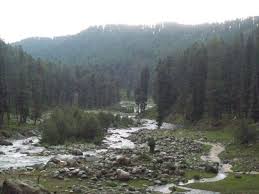
Yusmarg is a small meadow set in the heart of mountains to the south-west of Srinagar. Yusmarg is an ideal day-picnic resort. Yusmarg is approximately 47 km from the Srinagar and lies in the Badgam district of Jammu and Kashmir. The two-hour drive to the place is an enjoyment in itself. Grassy pastures stretching to acres of land, the dense forests full of pine trees, with the backdrop of splendid snow capped mountains leave you almost speechless.
Nearby are several peaks-Tatta Kutti and Sang Safed to name a couple of them. About 13 kms from Yusmarg, a short detour away from the Srinagar road, is Charari- Sharief, the Shrine of Kashmir's patron saint Sheikh Noor-ud-din or Nund Reshi, now rebuilt after the devastating fire of 1994 which engulfed the entire building.
Yusmarg is the perfect place to go for a picnic of one day. If one likes he can also even stay for a few days. Specially, for the lovers of long walks in picturesque locales, Yusmarg is the place to be.
Tourist Attractions: A short trek of 4km to Nil Nag a small lake amidst pine trees, near a hamlet gives an ultimate pleasure to visitors.
A full day trek from Yousmarg to frozen lake in Sang e safed valley 10 km from Yousmarg is quite fascinating one. Most of the portion of the lake is covered under ice throughout the year
Adventure Sports:
Trekking in Yousmarg: A major trekking route from Yousmarg eads to a famous spot called Tosa Maidan, a large meadow used for cattle grasing by nomads. This area is connected through rough routes to places like Gulmarg and Poonch. The region is full of springs , the one at Khag is most famous for the curative properties.
Camping: Yousmarg is prime attraction of the camping lovers School camps and adventure lovers make a week to fortnights stay at Yousmarg for ththrilling camping.
Horse Riding in Yousmarg
Best time to visit: Summer season is best time to visit Yousmarg ( May-October).
Where to Eat: JKTDC Restaurant near the Cottages offers all type of continental and Indian food for the visitors at economical price. Couple of local dhabas provide snacks ond quick meals during the daytime. It is advisable to carry your own packed food to visit the spot.
Where to Stay: Since Yousmarg is not so crowded like other tourist destinations, accommodation here is available only at JKTDC Tourist Bungalows & Hutments. The trekkers are advised to carry tents and other necessary food items for the stay.
How to reach: Yousmarg is accessible by road at 1 hour drive from Srinagar. The road remains closed from Tsrar-e-sharif during winters.
Nearby Locations:
Tsrar-e-Sharief:< About 13 kms from Yusmarg, a short detour away from the Srinagar road, is Charari- Sharief, the Shrine of Kashmir's patron saint Sheikh Noor-ud-din or Nund Reshi. Nund Reshi was the patron of the Sufism in Kashmir who showed disinterest in worldly matters from childhood and renounced the world at an early age of 12 in search of divinity of God . He was an illiterate Shiekh Noor-ud-Din Noorani RA popular as Nund Reshi or Alamdar-e- Kashmir was born in 1378 AD at Kaimuh a village in Anantnag district. When the people of valley were suffering and yet spontaneously uttered concise and rhythmic verses called 'Shruks' which are considered of high value in Kashmiri literature.
Gurez
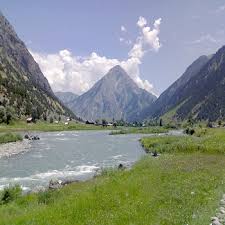
Situated in the North Eastern region of Kashmir is a small valley deep located in the high Himalayas at an altitude of about 8,000 ft above sea level, about 86 km from Bandipore and 123 km of Srinagar in northern Jammu and Kashmir. It is considered to be one of the most picturesque valleys of Kashmir and one cant believe his eyes on reaching there. Also termed as Gateway of the ancient 'Silk Route', Gurez also incorporates the famous pyramid shaped 'Habba Khatoon' peak named after the Kashmiri poetess. The valley is surrounded by snow capped mountains. It has diverse fauna and wildlife including the Himalayan Brown Bear and the Snow Leopard. The Neelum River flows through the valley.
The beautiful Kishen Ganga river flows through Gurez valley with its clear blue waters and rafting can be done here.
Best time to visit:
As the area remains cutt off from rest of the valley during winters, it opens in April-May and the best time to visit is May, June, July, August and September.
Clothes:
In Summer: Light woolen advisable.
In Winter: Heavy Woolen clothes.
Where to Stay:
Although the tourist related infrastructure is yet to be developed in this area, the accommodation facility is available in the main town of Dawar and the nearby villages.
Dal Lake
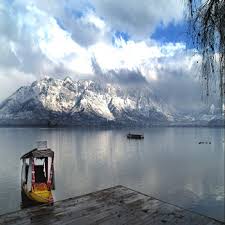
The Dal Lake is the most celebrated and important lake amongst all in Srinagar. It is home to carved wooden houseboats, vibrant shikaras and floating gardens. The backdrop to this eight kilometre long lake is the Pir Panjal mountain range, adding to the magnificence of this picture postcard vista. Don't forget to travel here early morning to see Srinagar's famous floating market.
Dal Lake, in Srinagar, the heart of Kashmir is the second largest lake in state, is integral to tourism and recreation in Kashmir and is named the "Jewel in the crown of Kashmir" or "Srinagar's Jewel". The shore line of the lake, is about 15.5 kilometres (9.6 mi), is encompassed by a boulevard lined with Mughal Gardens, parks, houseboats and hotels. Scenic views of the lake can be witnessed from the shore line Mughal gardens, such as Shalimar Bagh and Nishat Bagh built during the reign of Mughal Emperor Jahangir, and from houseboats cruising along the lake in the colourful shikaras. During the winter season, the Dal freezes and people enjoy walk over it.
The Dal Lake and the Shikaras are the photographers delight. During sunrise and sunset, the place bathed in golden light looks ethereal.
In Dal lake there is also a small island like park "Nehru Park" covered by water from all the sides and Char Chinari (Four Chinars in Dal Lake like a mini island).
Sports in Dal: One can enjoy Water Skiing, Motor Boats in Dal Lake.
Rides: Shikara ride is one of the main attraction of Dal lake which one should not miss to do.
Houseboat Stay: Houseboat stay is one of the famous attraction of Dal Lake, it is house in boat floating in Dal Lake, it is mesmerizing, one must stay at least on night in houseboat. One can find different types of rooms available in houseboat in all budget ranges.
Mughal Gardens

The Mughal Gardens of Srinagar are widely recognized for their picture-perfect sceneries, landscape, design and architecture which attract nature loving and professional photographers. Visitors coming to these gardens can take photographs of the colorful flower carpets, chinar trees and sculpted fountains. As these gardens offer vistas of Dal Lake and Zabarwan Mountains, visitors get some panoramic views to capture in their cameras. Besides this the Kashmiri traditional dress are also available on rent which one can hire to talk photographs in them.
Mughal Gardens are among the famous places in Srinagar which are every tourists choice, these gardens give different looks in different seasons of Kashmir which are equally attractive. These gardens are established during the Mughal era, these royal gardens are exemplary of fine landscaping and Mughal architecture blended with the ethereal beauty of nature. There are three such beautiful gardens in the city, they are Shalimar, Nishat and Chashme Shahi Gardens.
Shalimar garden: The largest and perhaps the most popular Mughal Garden in Srinagar is the Shalimar Bagh, which is situated along Dal Lake. Its other names are Shalamar Garden, Shalamar Bagh, Farah Baksh and Faiz Baksh It was laid in 1619 by Mughal emperor Jahangir for his beautiful wife Nur-Jahan. Divided into three terraced parts, this garden is lined with trails of chinar and carpeted with colourful flower beds. Exquisite arched niches called chini khanas form the highlight of this garden. The Bagh is considered the high point of Mughal horticulture. It is now a public park.
Nishat garden : Nishat Baghis a terraced Mughal garden built on the eastern side of the Dal Lake. It is the second largest garden after Shalimar Garden. 'Nishat Bagh' in Urdu, means 'Garden of Joy', 'Garden of Gladness' and 'Garden of Delight'. Located on the bank of the Dal Lake, with the Zabarwan Mountains as its backdrop, Nishat Bagh is a garden of bliss that commands a magnificent view of the lake beneath the snow-capped Pir Panjal mountain. This man-made landscaped was designed and built in 1633 by Asif Khan, elder brother of Nur Jehan. It is known for it 12 terraced formations, which represent different zodiac signs of astrology. The rectangular pool in the middle of this garden was formed by changing the course of a mountain stream.
Chashme Shahi Garden also known as Royal Spring, situated at the foothills of Zabarwan mountains in Srinagar, covering an area that is 108 metres in length and 38 metres in width, Chashme Shahi Garden is the smallest Mughal Garden but is equally picturesque and impressive as its counterparts. This garden earns fame for its natural springs of freshwater, which were discovered by Rupa Bhawani – a female saint from Srinagar. Emperor Shah Jahan laid this garden in 1632 and since then, it has never failed to impress visitors with its exceptional beauty.
The highlight of Chashme Shahi Garden is its natural spring of freshwater, which has mineral content. The garden provides splendid views of verdant greens, majestic mountain ranges and views of the Dal Lake. Pari Mahal and Char Chinar are few nearby attractions that are worth visiting.
Naseem Bagh : NaseemBagh, the 'Garden of Breezes' is one of the popular Mughal gardens in Kashmir. The site was built by famous Mughal Emperor, Akbar the Great in 1586 along the western banks of Dal Lake in Srinagar, Jammu-Kashmir. For upgradation of garden, Mughal Emperor Shah Jahan planted more than 1,200 trees in 1635.
Achabal

Achabal Achabal is situated at a distance of 58 km from the district of Srinagar, at an altitude of 1677 mtrs. Achabal is the most beautiful spring in Kashmir valley, which gushes out of the Sosanwar hill, is a visual treat for the eyes and was once enlisted by the emperor Jehangir in the service of beauty and pleasure. It is said that the Breng river which disappears at Dewalgam in the fissures of the limestone is the real source of the Achabal spring.
Achabal is about 7 kilometres away from Anantnag. The place is famous and attractive due to an ancient spring surrounded by a garden terraced and developed by the Mughals. The place has got some historical background also. The upper portion of the garden is called 'Bag-e-Begum Abad' developed by Malika Noor Jehan Begum in 1616 AD and renowned as Sahib Abad in which there is a Hamam (treasure of water) getting heat from a logical lamp (Tosnag).
Being at one and half hour drive distance from Srinagar, a tour to Achabal is the best one day trip place to witness the nature, charming Mughal architecture, it is the perfect weekend getaway from Srinagar.
Laid following the Persian style of gardening, one of the most popular styles of the Mughal era, the Garden is a riot of colors while sparkling waters gush out of exquisitely designed fountains. The garden which is built on the foot of a hill is surrounded by a spell binding array of tall Chinar trees, which add a special touch of regality to the still stately Mughal Gardens at Achabal. A tour to Achabal during autumn is made even more special when these Chinar Trees turn red, it is a rare view which cant be experienced anywhere in India.
Aherbal

While visiting Aharbal , what is more entertaining is the trip itself. Aharbal is a tourist destination in the south-western part of Kashmir Valley in about 75 km south of Srinagar at an altitude of 2266 metres above sea level. It is located on the Veshu River, a tributary of the Jehlum River, in an alpine valley covered in pine and fir trees within the Pir Panjal Mountains. Aharbal is known for its waterfall, and is referred to as the Niagara Falls of Kashmir, owing to the volume of the water that falls. Besides this there are few meadows nearby Aharbal and one among them called Kungawatan and is very popular.
Aharbal is also base for adventure tourism. Like Trekking, Angling, Camping and Fishing can be experienced here. From Aharbal trekkers take route leading to the beautiful lake called Kounsernag which is a two day trek. And also Treks alongside the lake in the Pir Panjal range are quite popular among the trekkers. The fishing permit can be obtained from the Fisheries department stationed at Aharbal.
How to Reach: Aharbal is easily accessible from Srinagar and is about 75 kms drive from Srinagar, and only 8 kms from the Mughal Road that connects Srinagar and Poonch.
Kheer Bhawani Temple
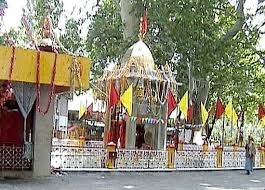
Kheer Bhawani Temple is a famous Hindu Temple, situated in the Tulla Mulla village at a distance of 14 miles from Srinagar, it is dedicated to the Goddess Kheer Bhawani (Bhawani Orginally) and is constructed over a sacred spring, which is said to change its colours .The worship of Kheer Bhawani is universal among the Hindus of Kashmir. The term kheer refers to rice pudding that is offered in the spring to propitiate the Goddess, which became part of the name of the temple. As is the custom with Hindu deities, she has many names: Maharagya Devi, Ragnya Devi, Rajni, Ragnya Bhagwati, and so on. Goddess Ragnya Devi – an incarnation of Goddess Durga – is the presiding deity of this temple.
Maharaja Pratap Singh built this temple in 1912, which was later renovated by Maharaja Hari Singh. The shrine has a hexagonal spring and a small marble shrine where the goddess idol is installed. According to legends, Lord Rama worshipped the goddess during his exile. He expressed his desire of shifting the holy seat to Shadipora, which was fulfilled by Lord Hanuman. The temple was shifted to its present site after the goddess appeared in the dream of a local pundit named Rugnath Gadroo.
On the eighth day of the full moon in May, devotees gather at the Kheer Bhawani Temple and observe fasts. It is believed that Goddess Ragnya changes the spring's colour on this auspicious day. If the colour changes to black, it is considered a bad omen that would result in a disaster in the valley. The temple organises fairs and yagnas during its annual festival and navratras, which attract a large number of devotees. Hawans on Shukla Paksh Ashtami are also common in this temple.
Shankaracharya Hill
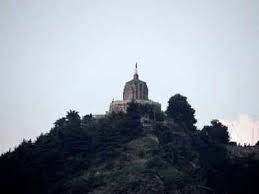
The Shankaracharya Hill is a part of the Zabarwan Mountain. It is one of the most revered Hindu pilgrimage destinations in Srinagar, the Shankaracharya Temple (Jyesteshwara Temple )is located atop this hill, it is also known as 'Takht-e-Suleiman' (Throne of Solomon). The ancient temple stands at a height of about 1100 feet above the surface level of the main Srinagar city. A visit to this sacred temple involves a trek to the top of the hills.
Devoted to the worship of Lord Shiva, Shankaracharya Temple is believed to have been built by Raja Gopadatya in 371 BC. During those times, the temple was known as Gopadri. The great saint Shankaracharya is supposed to have stayed here when he visited Kashmir in the early part of the ninth century with the primary aim of spreading the philosophy of Vedanta. This perhaps led to the renaming of the temple as Shankaracharya Temple. Shankaracharya was also instrumental in popularizing the worship of Lord Shiva in Jammu and Kashmir. Shankaracharya Temple is also a monument of great significance, not only because of its religious importance, but also for its architectural beauty. An inscription in Persian inside the Shankaracharya Temple dates back to the reign of Mughal Emperor Shahjahan.
Other Places
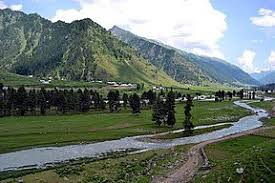
Whenever we talk of Kashmir's magnificence, the names of the most prominent places like Pahalgam, Gulmarg, Sonamarg, Mughal gardens etc instantly come to our minds but valley still has a lot of unexplored regions which are more beautiful and charming than these prominent places. Some of these unexplored tourist places ar:
Warwan Valley The efforts to reach this heavenly valley are worth it as you have to cross the tricky Margan Top (from where the famous Nun Kun peak can be seen on a clear day). A Gem in the unexplored Kashmir, Warwan valley in Kishtwar district situated at an altitude of approx 7000 feet from sea level offers breathtaking vistas of greenery, waterfalls and clear skies, the Warwan valley is sandwiched between Kashmir and Ladakh.
Lack of electricity in this valley takes your soul closer to nature. On a moonlit night, one is enthralled by the sheer beauty of the snow peaks of Zanskar range and the shimmering Dariya-E-Chinab flowing through the valley with distant echoes of shepherds getting their ships back home.
The Inshaan village has couple of accommodation facilities – a dak bunglow under construction and a Forest Rest House.
Here, the Kashmiri hospitality comes to act and any of the locals will accommodate you. The recently opened Vailoo-Inshan Road makes life easy as you can drive a vehicle (4X4 preferred) in the Warwan valley. Generally cut from the rest of the world for 7 months.
Best time to visit Warwan Valley is between May and October.
Bangus/ Reshwari: One of the relatively unknown areas of Kashmir with vast tourism potential is the valley of Bungus. The Bungus Valley that lies at an altitude of 10,000 ft ASL and located in the northern border district of Kupwara Kashmir presents ideal conditions for recreation. It is an Eco-Toursim place Eco tourism is an increasingly popular form of tourism in which tourists seek out wild and scenic areas such as mountains for an active and educational trip. Most of the tourists engaged in eco-tourism in Kashmir are from the North America, Europe, Australia and New Zealand often venturing the unexplored areas of the developing world. Bangus valley humbles the best of the European meadows. There are two elliptical bowl shaped valleys with name of Bodh Bungus (Big Bungus) and Lakut Bangus (Small Bungus). Bangus valley is surrounded by Chowkibal Mountains on the northern side, Qazinag and Shamsbery Mountains on the western side. Besides other hills also seem to provide protection to the grassland namely; Meeldar, Nastichavan and Yaddil etc. Bangus comprises mountain grasslands and coniferous forests. This valley is also famous for caves of Kala Roos and one can see Stone Age wall paintings. There is myth that some of the caves go up to Russia. The Bangus valley certainly epitomizes Kashmir's heavenly beauty in the original way.
How to Reach: As they say, "Good things never come easy". If you happen to visit Bangus, you will not stop thanking your stars. To visit Bangus permission is required from Government forces. It is accessible by road, a couple of hours drive from. Generally tourists are allowed access to Big Bungus only. Situated inside a dense forest of the marvelous pines, the Bungus meadows are probably the most beautiful in Kashmir and an ideal place for camping (though it is not allowed and one is requested to be back to Reshwari before evening).
Where to Stay: The only accommodation near Bangus Valley is the beautiful guest house situated on the banks of Mawar river in the Reshwari Village falling in the Handwara sub-division.
Doodhpathari Doodh-e-pathri is yet another bowl shaped valley about 42 kms form Srinagar. Probably the simplest to approach out of all the destinations described, Doodpathari (or Dodhpathir in local dialect) is situated at a distance of 40 kilometers from Srinagar. Doodhpathris bowl shape green valley with a flowing Shali Ganga river flowing through the meadows makes a beautiful day trip destination from Srinagar, resounds with soft wind passing through the pine trees of the enclosures of the valley. It is also called as a "VALLEY OF MILK" because it produces rich milk in a large quantity. the name is derived from the abundance of milk in this area due to lush green meadows for the cattle. The shephards from the nearby villages get their cattle to graze here.
How to Reach: It is accessible by road and at 40 -60 minutes drive from Srinagar by car / bus.
Where to Stay: Mostly tourist prefer to stay at Srinagar for night. If anyone is interested to stay here, the JKTDC has built tourist guest houses where one can enjoy night stays also.
Toshamaidan: Toshamaidan is also Bowl shaped vast meadow like Gulmarg situated in District Budgam, it is covered with thick forests on one side and Mountains on other side, till 2014 it was army training / firing range but Government of Jammu and Kashmir cleared it from army and added as one more place of Attraction for tourists.
It is undeveloped yet, one cant find any market or accommodation for living at Toshmaidan.
It is trekkers, Hikers and Campers choice, it offers many trekking routes in and around its vicinity, it offers , trek to Doodh Pathri , trek to Gulmar and other higher reaches treks.
Daksum: Tucked away in a densely forested gorge at an altitude of 2438 m, Daksum is completely silent meadow. It is walkers paradise. Up the hills which are swathed in coniferous trees, past gurgling brooks, the simple, haunting notes of a flute will waft down to you from where an unseen shepherd tends his flock. For in the hills surrounding Daksum, suddenly you will find yourself in grassy meadows where sheep are taken to pasture.
Daksum is a reviving experience -the bracing mountain air, the solitude, the densely clad hills, and beyond them, snow covered mountains, all contribute to Daksum's mystique, making it the perfect retreat.
Wular Lake:
Wular Lake, is situated between the towns of Sopore and Bandipore, but major part of this lake lies in district Bandipora of Jammu and Kashmir. It is India's largest fresh water lake and is one of the Asia's largest fresh water Lake, covering an area of about 125 sq km. The natural beauty of this lake, being located amidst snow clad hills, is undoubtedly beyond description.
Shrine of famous Muslim Sufi Saint Baba Shakur-u-Din lies nearby this Lake, on a hillock from where one can have a magnificent view of Wular Lake. The view of Wular lake from Baba Shakur-u-Din hill is a recommended visit.
People also visit this lake to see the migratory birds and the nearby Nal Sarovar Bird Sanctuary. Terrestrial birds such as eared kite, sparrow hawk, Short-Toed Eagle, Himalayan Golden Eagle, Blue Rock Pigeon, Cuckoo, Alpine Swift, Kashmir Roller, Himalayan Pied Woodpecker, and Golden Oriole etc can often be seen near the lake.
One can also enjoy Boating, water sports and water Ski Wular lake as these have been recently launched by J&K Tourism.
Besides this Wular Lake also serves as the livelihood source for thousands of fishermen.


